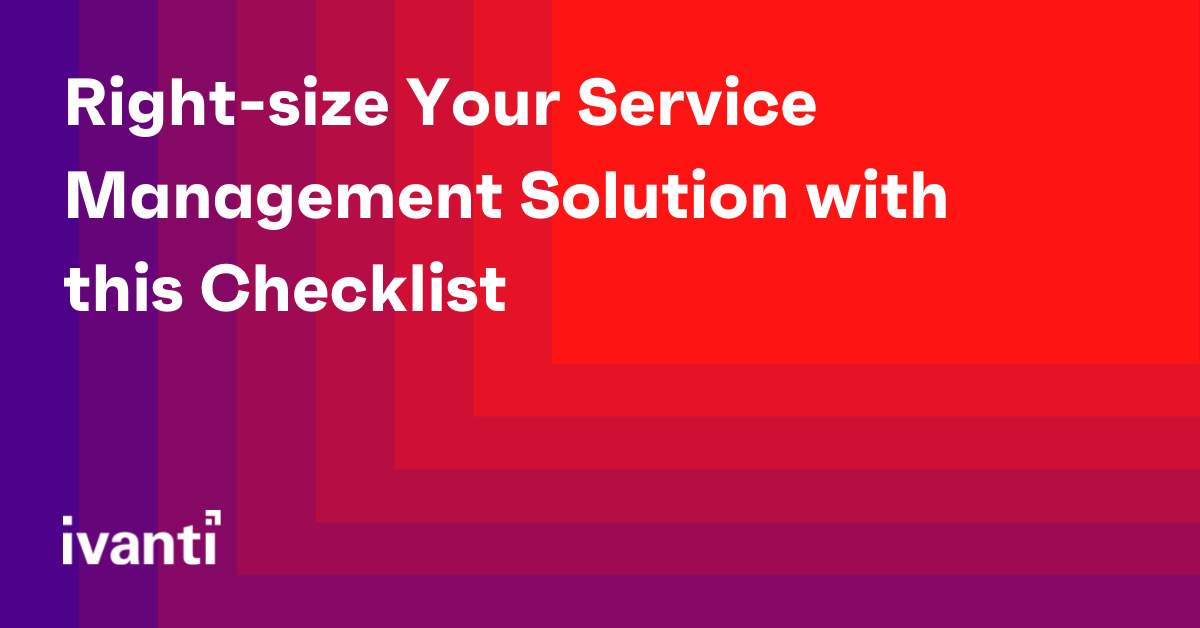Right-size Your Service Management Solution with this Checklist
Like most of you, I have been working from home for the last 12 months and now with vaccines being rolled out I hope we are at the end of this long tunnel. During this period, I noticed that my weight has been steadily creeping up, so, to get fit I decided to start cycling again and get myself a new road bike.
1. Do Your Research Before Shopping
As with any significant purchase I make, I did my research, put my checklist together and scanned the market. At the store, I pulled out my checklist and narrowed down the selection to two bikes - both are trusted brands with quality carbon frames and parts. The price difference was huge, where the top-of-the-line bike costs three times more than the other! The store owner was an honest and genuine person and recommended I go with the bike that fit my criteria. It came down to the following considerations:
- Budget - after doing my research, I knew what my limit was. The expensive bike came with pricey parts and accessories that I did not need
- On-going maintenance and cost - due to the high-tech parts, most adjustments and servicing requires a trained specialist
- My skill level - let's be honest here, I am not going to compete in the Tour de France, so I don’t really a bike specially designed for pro athletes
When I am not cycling, I am a Solutions Consultant at Ivanti and have been in the enterprise service management industry for over 25 years helping customers with their service management practices and solutions. When a customer comes to Ivanti for a solution, I feel that customers should have the same approach I did and select the software (and vendor) that is right for them based on the above criteria.
2. Work to Your Budget
After doing your market research and getting the approvals to purchase a new software, you will have a budget to work with. There are hundreds of Service Management software vendors in the market and a good place to help you get to your shortlist is the Gartner Magic Quadrant for IT Service Management Tools.
Like the bike I was admiring, service management systems will have lots of bells and whistles that you do not need but are included in the total cost. Ivanti allows you to decide which Service Management bundle is best suited for the different types of users:
- Help Desk - for Service Desk Analysts to manage Incident and Requests
- Service Desk - includes Service Transition modules like Change and Configuration Management
- Service Management - complete package with all ITIL processes
- Asset Management – to manage the complete lifecycle of your company assets
In addition to picking the right bundle for your users, Ivanti gives you the option to decide on concurrent vs named licenses. It only makes sense to get fixed named licenses for users that will be using the system all day, while casual users can utilise a pool of concurrent licenses.
3. Consider On-going Maintenance and Costs
Even if budget wasn’t an issue, you do have to consider the on-going cost to maintain the system. We know that business needs can change very quickly and IT has to work with the business to meet their new requirements. This could be some changes to the Incident Management workflow, integration or even expanding the solution to meet your Enterprise Service Management (ESM) needs eg. Human Resources and Facilities. Are you able to configure the system in-house to adapt to these changes or does it require a specialist from the vendor or partner? How much will this cost your organisation each year? Do you have to pay for additional ESM modules or add-ons?
Having the ability to configure and maintain the system in-house is critical to the success or failure of the implementation. Not only will this help to manage the cost but it will foster a sense of ownership of the system. It is better to invest in your staff development by training them and allowing the team to enhance the platform. As your team gains more confidence with the system, more modules, features and functionality will be utilised, giving you a valuable return on your investment.
Finally, you are able to keep all the knowledge within the organisation, without having to rely on costly services engagement every time a modification is needed. Organisations like Custom Fleet, Australian fleet company which manages and leases over 100,000 vehicles across Australia and New Zealand, have been through this journey moving from a platform that was costing them too much every year and was severely under-utilised. They could not justify the business case for continuing on that platform and so transitioned to Ivanti Service Manager.
4. Match to Maturity Level
We have seen many organisations spend six to seven figure amounts purchasing and attempting to implement a whole of business ESM solution with the end result delivering only Incident, Service Request and Change Management. It is important to select a solution that is the right fit for your organisation based on organisational maturity level. Ivanti Service Manager is ranked the highest in the Gartner Critical Capabilities report for Intermediate-Maturity Infrastructure and Operations, where the majority of organisations sit. Ivanti Service Manager can deliver the best time-to-value with the right licenses and faster deployment.
Reach out for Assistance
Ivanti Service Manager is a trusted ITIL v4 based service management platform that is available in the cloud and on-premise we have helped many organisations find the right-size Enterprise Service Management solution, so please reach out to find out more.
And for those of you wondering which bike I ended up bringing home with me, it was the right-size bike and not the over-priced, high maintenance bike that was never suited for me.
